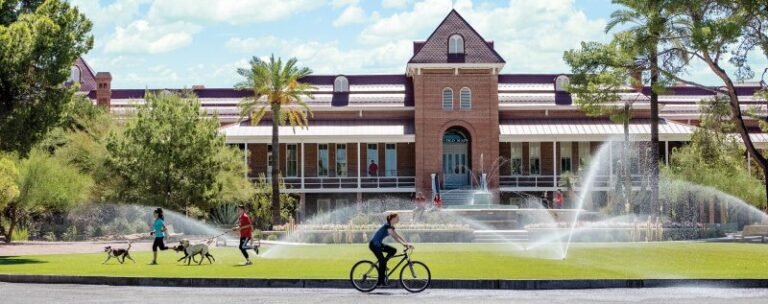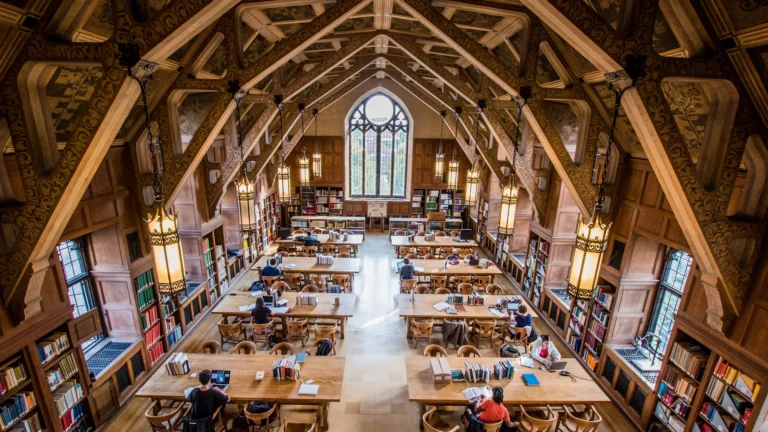University of Oxford, UK
Oxford College” redirects right here. For different makes use of, see Oxford University (disambiguation).
| Coat of arms | |
| Latin: Universitas Oxoniensis | |
| Different title | The Chancellor, Masters and Students of the College of Oxford[1] |
|---|---|
| Motto | Latin: Dominus illuminatio mea |
| Motto in English | The Lord is my light |
| Kind | Public research university |
| Established | c. 1096; 928 years in the past[2] |
| Endowment | £8.066 billion (2023; together with faculties)[5] |
| Price range | £2.924 billion (2022/23)[4] |
| Chancellor | The Lord Patten of Barnes |
| Vice-Chancellor | Irene Tracey[6] |
| Tutorial employees | 6,945 (2022)[7] |
| College students | 26,945 (2023)[8][9] |
| Undergraduates | 12,580 |
| Postgraduates | 13,445 |
| Different college students | 430 |
| Location | Oxford, England 51°45′18″N 01°15′18″W 51°45′18″N 01°15′18″W |
| Campus | University town |
| Colours | Oxford Blue[10] |
| Affiliations | ACUEUAEuropaeumIARULERURussell GroupSESUniversities UK |
| Web site | ox.ac.uk |
The College of Oxford is a collegiate research university in Oxford, England. There may be proof of educating as early as 1096,[2] making it the oldest college within the English-speaking world and the world’s second-oldest university in continuous operation.[2][11][12] It grew quickly from 1167, when Henry II banned English college students from attending the University of Paris.[2] After disputes between college students and Oxford townsfolk in 1209, some teachers fled north-east to Cambridge the place they established what turned the University of Cambridge.[13] The 2 English ancient universities share many widespread options and are collectively known as Oxbridge.[14]
The College of Oxford is made up of thirty-nine semi-autonomous constituent colleges, 4 permanent private halls, and a variety of educational departments that are organised into 4 divisions.[15] Every faculty is a self-governing establishment inside the college, controlling its personal membership and having its personal inside construction and actions. All college students are members of a faculty.[16]
It doesn’t have a fundamental campus, however its buildings and amenities are scattered all through town centre. Undergraduate teaching at Oxford consists of lectures, small-group tutorials on the faculties and halls, seminars, laboratory work and infrequently additional tutorials supplied by the central college colleges and departments. Postgraduate teaching is supplied in a predominantly centralised trend.
Oxford operates the Ashmolean Museum, the world’s oldest university museum; Oxford University Press, the most important university press on the earth; and the most important educational library system nationwide.[17] Within the fiscal yr ending 31 July 2023, the college had a complete consolidated revenue of £2.92 billion, of which £789 million was from analysis grants and contracts.[4]
Oxford has educated a variety of notable alumni, together with 30 prime ministers of the United Kingdom and lots of heads of state and authorities around the globe.[18] As of October 2022, 73 Nobel Prize laureates, 4 Fields Medalists, and 6 Turing Award winners have matriculated, labored, or held visiting fellowships on the College of Oxford, whereas its alumni have gained 160 Olympic medals.[19] Oxford is the house of quite a few scholarships, together with the Rhodes Scholarship, one of many oldest worldwide graduate scholarship programmes.
Historical past[edit]
See additionally: Timeline of Oxford
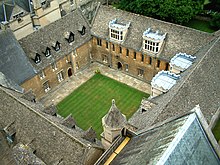

Founding[edit]
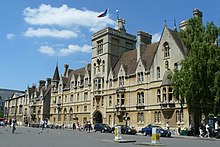
The College of Oxford’s basis date is unknown.[20] It’s recognized that educating at Oxford existed in some type as early as 1096, however it’s unclear when the college got here into being.[2] Scholar Theobald of Étampes lectured at Oxford within the early 1100s.
It grew rapidly from 1167 when English college students returned from the University of Paris.[2] The historian Gerald of Wales lectured to such students in 1188, and the primary recognized overseas scholar, Emo of Friesland, arrived in 1190. The pinnacle of the college had the title of chancellor from a minimum of 1201, and the masters have been recognised as a universitas or company in 1231.[2][21] The college was granted a royal constitution in 1248 in the course of the reign of King Henry III.[22]
After disputes between college students and Oxford townsfolk in 1209, some teachers fled from the violence to Cambridge, later forming the University of Cambridge.[13][23]
The scholars related collectively on the premise of geographical origins, into two ‘nations‘, representing the North (northerners or Boreales, who included the English people from north of the River Trent and the Scots) and the South (southerners or Australes, who included English folks from south of the Trent, the Irish and the Welsh).[24][25] In later centuries, geographical origins continued to affect many college students’ affiliations when membership of a college or hall turned customary in Oxford. As well as, members of many religious orders, together with Dominicans, Franciscans, Carmelites and Augustinians, settled in Oxford within the mid-Thirteenth century, gained affect and maintained homes or halls for college kids.[26] At about the identical time, non-public benefactors established faculties as self-contained scholarly communities. Among the many earliest such founders have been William of Durham, who in 1249 endowed University College,[26] and John Balliol, father of a future King of Scots; Balliol College bears his title.[24] One other founder, Walter de Merton, a Lord Chancellor of England and afterwards Bishop of Rochester, devised a sequence of rules for school life;[27][28] Merton College thereby turned the mannequin for such institutions at Oxford,[29] in addition to on the College of Cambridge. Thereafter, an rising variety of college students lived in faculties slightly than in halls and non secular homes.[26]
In 1333–1334, an try by some dissatisfied Oxford students to discovered a brand new university at Stamford, Lincolnshire, was blocked by the colleges of Oxford and Cambridge petitioning King Edward III.[30] Thereafter, till the 1820s, no new universities have been allowed to be based in England, even in London; thus, Oxford and Cambridge had a duopoly, which was uncommon in massive western European nations.[31][32]
Renaissance interval[edit]

The brand new studying of the Renaissance tremendously influenced Oxford from the late fifteenth century onwards. Amongst college students of the interval have been William Grocyn, who contributed to the revival of Greek language research,[33] and John Colet, the famous biblical scholar.[34]
With the English Reformation and the breaking of communion with the Roman Catholic Church, recusant students from Oxford fled to continental Europe, settling particularly on the University of Douai.[35] The strategy of educating at Oxford was reworked from the medieval scholastic method to Renaissance training, though establishments related to the college suffered losses of land and revenues. As a centre of studying and scholarship, Oxford’s repute declined within the Age of Enlightenment; enrolments fell and educating was uncared for.[36]
In 1636,[37] William Laud, the chancellor and Archbishop of Canterbury, codified the college’s statutes. These, to a big extent, remained its governing rules till the mid-Nineteenth century. Laud was additionally accountable for the granting of a constitution securing privileges for the University Press, and he made vital contributions to the Bodleian Library, the primary library of the college. From the beginnings of the Church of England because the established church till 1866, membership of the church was a requirement to graduate as a Bachelor of Arts, and “dissenters” have been solely permitted to be promoted to Grasp of Arts in 1871.[38]
The college was a centre of the Royalist get together in the course of the English Civil War (1642–1649), whereas the city favoured the opposing Parliamentarian trigger.[39]
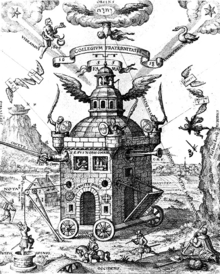
Wadham College, based in 1610, was the undergraduate faculty of Sir Christopher Wren. Wren was a part of an excellent group of experimental scientists at Oxford within the 1650s, the Oxford Philosophical Club, which included Robert Boyle and Robert Hooke. This group, which has at occasions been linked with Boyle’s “Invisible College“, held common conferences at Wadham underneath the steering of the faculty’s Warden, John Wilkins, and the group shaped the nucleus that went on to discovered the Royal Society.[40]
Trendy interval[edit]
College students[edit]
Earlier than reforms within the early Nineteenth century, the curriculum at Oxford was notoriously slim and impractical. Sir Spencer Walpole, a historian of latest Britain and a senior authorities official, had not attended any college. He stated, “Few medical males, few solicitors, few individuals meant for commerce or commerce, ever dreamed of passing via a college profession.” He quoted the Oxford College Commissioners in 1852 stating: “The training imparted at Oxford was not resembling to conduce to the development in lifetime of many individuals, besides these meant for the ministry.”[41] Nonetheless, Walpole argued:
Among the many many deficiencies attending a college training there was, nonetheless, one advantage of it, and that was the training which the undergraduates gave themselves. It was not possible to gather some thousand or twelve hundred of the very best younger males in England, to provide them the chance of constructing acquaintance with each other, and full liberty to dwell their lives in their very own approach, with out evolving in the very best amongst them, some admirable qualities of loyalty, independence, and self-control. If the common undergraduate carried from College little or no studying, which was of any service to him, he carried from it a data of males and respect for his fellows and himself, a reverence for the previous, a code of honour for the current, which couldn’t however be serviceable. He had loved alternatives… of intercourse with males, a few of whom have been sure to rise to the very best locations within the Senate, within the Church, or on the Bar. He may need blended with them in his sports activities, in his research, and maybe in his debating society; and any associations which he had this shaped had been helpful to him on the time, and could be a supply of satisfaction to him in after life.[42]
Out of the scholars who matriculated in 1840, 65% have been sons of execs (34% have been Anglican ministers). After commencement, 87% turned professionals (59% as Anglican clergy). Out of the scholars who matriculated in 1870, 59% have been sons of execs (25% have been Anglican ministers). After commencement, 87% turned professionals (42% as Anglican clergy).[43][44]
M. C. Curthoys and H. S. Jones argue that the rise of organised sport was some of the outstanding and distinctive options of the historical past of the colleges of Oxford and Cambridge within the late Nineteenth and early twentieth centuries. It was carried over from the athleticism prevalent on the public faculties resembling Eton, Winchester, Shrewsbury, and Harrow.[45]
All college students, no matter their chosen space of examine, have been required to spend (a minimum of) their first yr making ready for a first-year examination that was closely centered on classical languages. Science college students discovered this notably burdensome and supported a separate science diploma with Greek language examine faraway from their required programs. This idea of a Bachelor of Science had been adopted at different European universities (London University had carried out it in 1860) however an 1880 proposal at Oxford to exchange the classical requirement with a contemporary language (like German or French) was unsuccessful. After appreciable inside wrangling over the construction of the humanities curriculum, in 1886 the “pure science preliminary” was recognised as a qualifying a part of the primary yr examination.[46]
At first of 1914, the college housed about 3,000 undergraduates and about 100 postgraduate college students. In the course of the First World Conflict, many undergraduates and fellows joined the armed forces. By 1918 nearly all fellows have been in uniform, and the scholar inhabitants in residence was diminished to 12 per cent of the pre-war whole.[47] The University Roll of Service data that, in whole, 14,792 members of the college served within the battle, with 2,716 (18.36%) killed.[48] Not all of the members of the college who served within the Nice Conflict have been on the Allied facet; there’s a outstanding memorial to members of New School who served within the German armed forces, bearing the inscription, ‘In reminiscence of the boys of this school who coming from a overseas land entered into the inheritance of this place and returning fought and died for his or her nation within the battle 1914–1918’. In the course of the battle years the college buildings turned hospitals, cadet faculties and navy coaching camps.[47]
Reforms[edit]
Two parliamentary commissions in 1852 issued suggestions for Oxford and Cambridge. Archibald Campbell Tait, a former headmaster of Rugby Faculty, was a key member of the Oxford Fee; he wished Oxford to observe the German and Scottish mannequin through which the professorship was paramount. The fee’s report envisioned a centralised college run predominantly by professors and colleges, with a a lot stronger emphasis on analysis. The skilled employees must be strengthened and higher paid. For college kids, restrictions on entry must be dropped, and extra alternatives given to poorer households. It referred to as for an enlargement of the curriculum, with honours to be awarded in lots of new fields. Undergraduate scholarships must be open to all Britons. Graduate fellowships must be opened as much as all members of the college. It beneficial that fellows be launched from an obligation for ordination. College students have been to be allowed to save cash by boarding within the metropolis, as an alternative of in a university.[49][50]
The system of separate honour schools for various topics started in 1802, with Arithmetic and Literae Humaniores.[51] Faculties of “Pure Sciences” and “Legislation, and Trendy Historical past” have been added in 1853.[51] By 1872, the final of those had cut up into “Jurisprudence” and “Trendy Historical past”. Theology turned the sixth honour college.[52] Along with these B.A. Honours levels, the postgraduate Bachelor of Civil Law (B.C.L.) was, and nonetheless is, supplied.[53]
The mid-Nineteenth century noticed the affect of the Oxford Movement (1833–1845), led amongst others by the longer term Cardinal John Henry Newman.
Administrative reforms in the course of the Nineteenth century included the substitute of oral examinations with written entrance assessments, better tolerance for religious dissent, and the institution of 4 girls’s faculties. Privy Council selections within the twentieth century (e.g. the abolition of obligatory day by day worship, dissociation of the Regius Professorship of Hebrew from clerical standing, diversion of schools’ theological bequests to different functions) loosened the hyperlink with conventional perception and follow. Moreover, though the college’s emphasis had traditionally been on classical data, its curriculum expanded in the course of the Nineteenth century to incorporate scientific and medical research.
The College of Oxford started to award doctorates for analysis within the first third of the twentieth century. The primary Oxford DPhil in arithmetic was awarded in 1921.[54]
The listing of distinguished students on the College of Oxford is lengthy and contains many who’ve made main contributions to politics, the sciences, drugs, and literature. As of October 2022, 73 Nobel laureates and greater than 50 world leaders have been affiliated with the College of Oxford.[18]
Ladies’s training[edit]
First two girls’s faculties
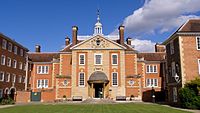
Lady Margaret Hall, based in 1878
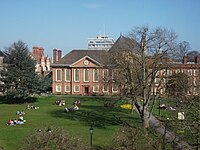
Somerville College, based in 1879
The college handed a statute in 1875 permitting examinations for ladies at roughly undergraduate stage;[55] for a short interval within the early 1900s, this allowed the “steamboat ladies” to obtain ad eundem levels from the University of Dublin.[56] In June 1878, the Association for the Education of Women (AEW) was shaped, aiming for the eventual creation of a faculty for ladies in Oxford. A few of the extra outstanding members of the affiliation have been George Granville Bradley, T. H. Green and Edward Stuart Talbot. Talbot insisted on a particularly Anglican establishment, which was unacceptable to a lot of the different members. The 2 events ultimately cut up, and Talbot’s group based Lady Margaret Hall in 1878, whereas T. H. Inexperienced based the non-denominational Somerville College in 1879.[57] Girl Margaret Corridor and Somerville opened their doorways to their first 21 college students (12 at Somerville, 9 at Girl Margaret Corridor) in 1879, who attended lectures in rooms above an Oxford baker’s store.[55] There have been additionally 25 girls college students dwelling at dwelling or with pals in 1879, a gaggle which developed into the Society of Oxford Dwelling-College students and in 1952 into St Anne’s College.[58][59]
These first three societies for ladies have been adopted by St Hugh’s (1886)[60] and St Hilda’s (1893).[61] All of those faculties later turned coeducational, beginning with Lady Margaret Hall and St Anne’s in 1979,[62][58] and ending with St Hilda’s, which started to simply accept male college students in 2008.[63] Within the early twentieth century, Oxford and Cambridge have been broadly perceived to be bastions of male privilege;[64] nonetheless, the mixing of girls into Oxford moved ahead in the course of the First World Conflict. In 1916 girls have been admitted as medical college students on a par with males, and in 1917 the college accepted monetary accountability for ladies’s examinations.[47]
On 7 October 1920 girls turned eligible for admission as full members of the college and got the precise to take levels.[65] In 1927 the college’s dons created a quota that restricted the variety of feminine college students to 1 / 4 that of males, a ruling which was not abolished till 1957.[55] Nonetheless, throughout this era Oxford faculties have been single sex, so the variety of girls was additionally restricted by the capability of the ladies’s faculties to confess college students. It was not till 1959 that the ladies’s faculties got full collegiate standing.[66]
In 1974, Brasenose, Jesus, Wadham, Hertford and St Catherine’s turned the primary beforehand all-male faculties to confess girls.[67][68] Nearly all of males’s faculties accepted their first feminine college students in 1979,[68] with Christ Church following in 1980,[69] and Oriel changing into the final males’s faculty to confess girls in 1985.[70] Most of Oxford’s graduate faculties have been based as coeducational institutions within the twentieth century, except St Antony’s, which was based as a males’s faculty in 1950 and commenced to simply accept girls solely in 1962.[71] By 1988, 40% of undergraduates at Oxford have been feminine;[72] in 2016, 45% of the scholar inhabitants, and 47% of undergraduate college students, have been feminine.[73][74]
In June 2017, Oxford introduced that beginning the next educational yr, historical past college students could select to take a seat a take-home examination in some programs, with the intention that it will equalise charges of firsts awarded to ladies and men at Oxford.[75] That very same summer season, maths and laptop science assessments have been prolonged by quarter-hour, in a bid to see if feminine scholar scores would enhance.[76][77]
The detective novel Gaudy Night by Dorothy L. Sayers, herself one of many first girls to achieve an instructional diploma from Oxford, is basically set within the all-female Shrewsbury College, Oxford (based mostly on Sayers’ personal Somerville College[78]), and the problem of girls’s training is central to its plot. Social historian and Somerville School alumna Jane Robinson‘s ebook Bluestockings: A Exceptional Historical past of the First Ladies to Battle for an Training provides a really detailed and immersive account of this historical past.[79]



